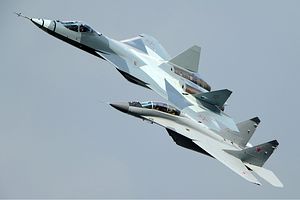India and Russia have been long-term collaborators on defense technology. The two countries together produced the supersonic BrahMos cruise missile — the fastest cruise missile in production. The relationship hasn’t always been balanced in India’s favor, however, and this has come to light recently with India’s stake in the development of the Fifth Generation Fighter Aircraft, based on the Russian Sukhoi T-50 (PAK FA).
According to Defense News, India has conveyed its displeasure to Russia over its “low level of participation in the joint development of the Fifth Generation Fighter Aircraft (FGFA), despite being an equal financial partner in the project and placing an order of more than US $30 billion for the new planes.” The joint effort is a major component of India’s continued air force modernization. According to RIA Novosti, India currently bears 50 percent of the costs of development.
In a visit to Moscow earlier this month, Indian Defense Minister A. K. Antony pushed Russia to increase India’s share of the development work to 50 percent, in line with its financial equity in the project. Antony, speaking at the 13th meeting of the India-Russia Inter-Governmental Commission on Military Technical Cooperation, stressed the necessity for the two longterm partners to cooperative equally in “all the phases — design, development and production — in the execution” of the FGFA project.
New Delhi’s push for equitable inclusion in military technical cooperation with Russia is related to its long-unachieved strategic goal of developing self-sufficiency in indigenous military production. India is the world’s largest importer of weapons technology. Indeed, Defense News cited a Russian diplomat in New Delhi as saying that part of the reason that the Russians limited India’s share in the FGFA project is due to “India’s capabilities in military aircraft research and industrial infrastructure.”
The agreement to jointly develop the FGFA was signed between the Indian and Russia Air Forces in 2007, with the final design, research, and joint development contract expected to exceed more than $10 billion. Although that contract is yet to be signed, Defense News reports that “In December 2010, Rosoboronexport, India’s state-owned Hindustan Aeronautics and Russian aircraft-maker Sukhoi signed a preliminary design development contract worth $295 million.”
The Indian Air Force is likely to order around 200 units of the single-seat, twin-engine fighters. The Sukhoi T-50 possesses a supersonic cruising ability which, combined with its ultra-manuverability, makes it a potent addition to the Indian Air Force. The jet is expected to increase the versatility of the Indian Air Force. As part of India’s stake in the development of the aircraft, it is expected to be able to specifically tune the units it purchases to the specific needs of its air force.
Antony’s visit to Moscow came just a couple days after India inducted the INS Vikramaditya — formerly the Russian Admiral Gorshkov. India’s naval modernization, which has reached new heights in recent years, has largely been dependent on its cooperation with Russia as well. In his recent visit, Antony also addressed a prospective nuclear submarine lease from Russia to India.
































